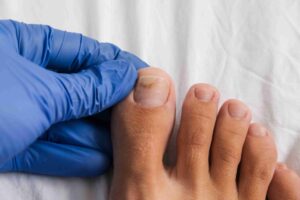Pemphigus Vulgaris of the Foot
Pemphigus vulgaris is a rare autoimmune disorder characterized by the formation of blisters and erosions on the skin and mucous membranes due to the body’s immune system mistakenly attacking proteins that help cells stick together. While it most commonly affects areas like the mouth and skin, it can also manifest on the feet. The body produces antibodies against desmogleins, proteins that help cells adhere to one another. This results in the separation of skin layers and the formation of blisters.
Symptoms of Pemphigus Vulgaris Specific to the Foot
- Blister Formation. Blisters can occur on any part of the foot, including:
- Plantar Surface: The soles of the feet, where weight is applied, can be particularly painful.
- Between Toes: Interdigital areas may develop blisters that can be prone to infection.
- Erosions. When blisters burst, they leave behind painful erosions that may weep or crust over.
- Secondary Infections. Open sores can become infected, leading to complications that may require additional treatment.
- Pain and Discomfort. Walking or standing may be uncomfortable due to pain from blisters or sores.
Here are some key factors believed to contribute to its development:
1. Autoimmune Response
- Antibodies Against Desmogleins: The body mistakenly produces antibodies against desmogleins, which are proteins that help skin cells adhere to one another. This leads to the breakdown of cell-to-cell connections causing blister formation.
2. Genetic Factors
- Family History: There may be a genetic predisposition, as individuals with a family history of autoimmune diseases are at a higher risk.
3. Environmental Triggers
- Medications: Certain drugs, such as penicillamine, can trigger pemphigus vulgaris in susceptible individuals.
- Infections: Some viral or bacterial infections might trigger the immune response leading to pemphigus.
- Sunlight: Exposure to ultraviolet light has been suggested as a potential trigger for the onset or exacerbation of symptoms.
4. Hormonal Factors
- Gender: Pemphigus vulgaris is more common in women, particularly those in middle age, which suggests that hormonal factors may play a role.
5. Other Autoimmune Conditions
- Comorbidities: Individuals with other autoimmune diseases (like rheumatoid arthritis or lupus) may be at an increased risk for developing pemphigus vulgaris.
Are you suffering from any hand or foot condition? At The Chelsea Clinic, we can help. One of our podiatrist can assist and then recommend what treatments are best to get you back on track. Podiatrist South Kensington
Schedule an appointment here or you may call us at +44 (0) 207 101 4000.
We hope you have a feetastic day!
-The Chelsea Clinic and Team
Learn more about Fungal Nails
Learn more about Diabetic Neuropathy here https://www.thechelseaclinic.uk/diabetic-neuropathy/
Read our blog about Diabetic Foot Ulcer https://www.thechelseaclinic.uk/diabetic-foot-ulcer/




